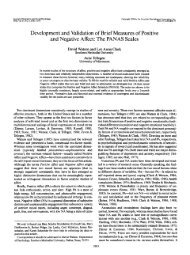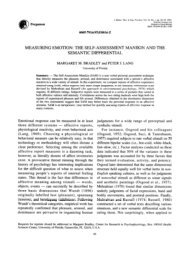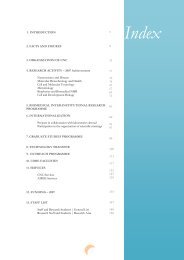Annual Report of Activities CNC 2008 - Center for Neuroscience and ...
Annual Report of Activities CNC 2008 - Center for Neuroscience and ...
Annual Report of Activities CNC 2008 - Center for Neuroscience and ...
Create successful ePaper yourself
Turn your PDF publications into a flip-book with our unique Google optimized e-Paper software.
Mitochondrial Dysfuntion <strong>and</strong> Cell Death | Head: Ana Cristina RegoObjectivesSelective neurodegeneration in irreversible disorders<strong>of</strong> the CNS has been largely attributed to proteinmisfolding, excitotoxicity <strong>and</strong> mitochondrialimpairment. However, how modified or mutantproteins interfere with mitochondrial <strong>and</strong> neuronalfunction is largely unclear. Furthermore, severalneurotoxic substances cause neuronal death throughchanges in mitochondrial activity, deregulation <strong>of</strong>intracellular calcium homeostasis <strong>and</strong> oxidativestress. Thus, the main objective <strong>of</strong> our group is tostudy defective intracellular signaling mechanisms<strong>and</strong> identify molecular targets <strong>for</strong> therapeuticintervention underlying excitotoxicity, mitochondrialdysfunction, oxidative stress <strong>and</strong> neuronal death inneurodegenerative diseases, including polyglutamineexpansion (Huntington’s (HD) <strong>and</strong> Machado‐Joseph’s (MJD) disorders), Parkinson’s (PD) <strong>and</strong>Alzheimer’s (AD) diseases, <strong>and</strong> in the neuropathologycaused by drug addiction. We also aim to evaluatethe efficacy <strong>of</strong> neuroprotective strategies (pharmacological<strong>and</strong> cell replacement therapies) that help recoveringcell function <strong>and</strong> thus cell survival in animal <strong>and</strong>cellular models <strong>of</strong> neurodegenerative disorders.The protective effect <strong>of</strong> growth factors that act astrophic signalling molecules assumes a highimportance in neurodegeneration. There<strong>for</strong>e, wewill examine the influence <strong>of</strong> brain‐derivedneurotrophic (BDNF) <strong>and</strong> glial cell‐derivedneurotrophic factor (GDNF) either directly or aftertransduction into stem cells acquiring a neuralphenotype, <strong>and</strong> the neuroprotective effect <strong>of</strong>insulin‐growth factor (IGF‐1), insulin <strong>and</strong> histonedeacetylase modulators in PD <strong>and</strong> HD models.derived from HD knock‐in mice. Mutant cellsrevealed increased ROS <strong>for</strong>mation, decreased GSHsynthesis <strong>and</strong> in the activity <strong>of</strong> antioxidantenzymes. We further studied markers <strong>of</strong> apoptosis<strong>and</strong> mitochondrial dysfunction in peripheral bloodcells <strong>of</strong> HD patients (Almeida et al, <strong>2008</strong>). Wefound increased Bax expression in B <strong>and</strong> Tlymphocytes, <strong>and</strong> monocytes from HD patients. Blymphocytes also showed decreased mitochondrialpotential, suggesting that these cells may reflectchanges observed in HD brain. In the context <strong>of</strong>MJD, we observed an increase in ataxin‐3deubiquitinating activity in vitro after long periods<strong>of</strong> incubation with valosin‐containing protein(VCP/p97). Using human SH‐SY5Y cells transfectedwith WT <strong>and</strong> mutant A53T alpha‐synuclein (a‐syn)subjected to iron <strong>and</strong> rotenone as models <strong>of</strong> PD, wedetected increased P‐Ser129‐a‐syn, decreasedmitochondrial potential <strong>and</strong> ROS production, inthe absence <strong>of</strong> a‐syn aggregates. Within the scope<strong>of</strong> AD pathogenesis, we observed that amyloidbetapeptide (Abeta) oligomers increase NR2A denovo protein synthesis, but enhance membranesurface <strong>of</strong> NR2B NMDAR subunits in maturehippocampal neurons. Abeta evoked calcium risesensitive to NMDAR antagonists <strong>and</strong> decreasedtubulin‐beta III levels, suggesting the involvement<strong>of</strong> NMDAR subunits on neuronal dysfunctioncaused by Abeta oligomers. Regarding research ondrugs <strong>of</strong> abuse we showed that combination <strong>of</strong>cocaine <strong>and</strong> heroin enhances the neurotoxicity <strong>of</strong>the drugs alone <strong>and</strong> that cocaine‐morphine adductsshift cell death pathways towards necrosis.25Main AchievementsIn the context <strong>of</strong> HD, our group showed thatactivation <strong>of</strong> BDNF signaling pathways prevent 3‐NP toxicity <strong>and</strong> transcriptional deregulation inneurons. We also observed alterations in themitochondrial proteome <strong>of</strong> HD mice brain <strong>and</strong> incomplex I activity, which were prevented byBDNF. These data implicate expression <strong>of</strong>mitochondrial proteins <strong>and</strong> molecular activity inthis organelle as HD therapeutic targets. Moreover,we demonstrated insulin neuroprotection againstoxidative stress through increased expression <strong>of</strong>proteins involved in antioxidant defense, glucosemetabolism <strong>and</strong> prevention against apoptosis(Duarte et al, <strong>2008</strong>). We also observed insulinprotection against oxidative stress in striatal cellsInsulin‐mediated mRNA expression <strong>of</strong> glutathione peroxidase‐1 (A), hexokinase‐II (B), Bcl‐2 (C) <strong>and</strong> caspase‐3 (D) uponoxidative stress in cultured cortical neurons labeling theinsulin receptor (IR) (E) [Duarte et al., <strong>2008</strong>].






